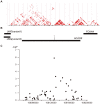A single nucleotide polymorphism within the acetyl-coenzyme A carboxylase beta gene is associated with proteinuria in patients with type 2 diabetes
- PMID: 20168990
- PMCID: PMC2820513
- DOI: 10.1371/journal.pgen.1000842
A single nucleotide polymorphism within the acetyl-coenzyme A carboxylase beta gene is associated with proteinuria in patients with type 2 diabetes
Abstract
It has been suggested that genetic susceptibility plays an important role in the pathogenesis of diabetic nephropathy. A large-scale genotyping analysis of gene-based single nucleotide polymorphisms (SNPs) in Japanese patients with type 2 diabetes identified the gene encoding acetyl-coenzyme A carboxylase beta (ACACB) as a candidate for a susceptibility to diabetic nephropathy; the landmark SNP was found in the intron 18 of ACACB (rs2268388: intron 18 +4139 C > T, p = 1.4x10(-6), odds ratio = 1.61, 95% confidence interval [CI]: 1.33-1.96). The association of this SNP with diabetic nephropathy was examined in 9 independent studies (4 from Japan including the original study, one Singaporean, one Korean, and two European) with type 2 diabetes. One case-control study involving European patients with type 1 diabetes was included. The frequency of the T allele for SNP rs2268388 was consistently higher among patients with type 2 diabetes and proteinuria. A meta-analysis revealed that rs2268388 was significantly associated with proteinuria in Japanese patients with type 2 diabetes (p = 5.35 x 10(-8), odds ratio = 1.61, 95% Cl: 1.35-1.91). Rs2268388 was also associated with type 2 diabetes-associated end-stage renal disease (ESRD) in European Americans (p = 6 x 10(-4), odds ratio = 1.61, 95% Cl: 1.22-2.13). Significant association was not detected between this SNP and nephropathy in those with type 1 diabetes. A subsequent in vitro functional analysis revealed that a 29-bp DNA fragment, including rs2268388, had significant enhancer activity in cultured human renal proximal tubular epithelial cells. Fragments corresponding to the disease susceptibility allele (T) had higher enhancer activity than those of the major allele. These results suggest that ACACB is a strong candidate for conferring susceptibility for proteinuria in patients with type 2 diabetes.
Conflict of interest statement
The authors have declared that no competing interests exist.
Figures



Similar articles
-
The acetyl-coenzyme A carboxylase beta (ACACB) gene is associated with nephropathy in Chinese patients with type 2 diabetes.Nephrol Dial Transplant. 2010 Dec;25(12):3931-4. doi: 10.1093/ndt/gfq303. Epub 2010 Jun 2. Nephrol Dial Transplant. 2010. PMID: 20519229 Free PMC article.
-
An ACACB variant implicated in diabetic nephropathy associates with body mass index and gene expression in obese subjects.PLoS One. 2013;8(2):e56193. doi: 10.1371/journal.pone.0056193. Epub 2013 Feb 27. PLoS One. 2013. PMID: 23460794 Free PMC article.
-
The ACACB gene rs2268388 polymorphism is associated with nephropathy in Caucasian patients with diabetes: a meta-analysis.Ren Fail. 2015 Jul;37(6):925-8. doi: 10.3109/0886022X.2015.1052978. Epub 2015 Jun 1. Ren Fail. 2015. PMID: 26030797 Review.
-
Acetyl-coenzyme A carboxylase beta gene polymorphism does not predict cardiovascular risk susceptibility in Chinese type 2 diabetic individuals.Nephrology (Carlton). 2022 May;27(5):404-409. doi: 10.1111/nep.14017. Epub 2022 Jan 5. Nephrology (Carlton). 2022. PMID: 34939260
-
The association between lipid metabolism gene polymorphisms and nephropathy in type 2 diabetes: a meta-analysis.Int Urol Nephrol. 2015 Jan;47(1):117-30. doi: 10.1007/s11255-014-0843-6. Epub 2014 Sep 28. Int Urol Nephrol. 2015. PMID: 25262148 Review.
Cited by
-
Genetic and environmental factors associated with type 2 diabetes and diabetic vascular complications.Rev Diabet Stud. 2012 Spring;9(1):6-22. doi: 10.1900/RDS.2012.9.6. Epub 2012 May 10. Rev Diabet Stud. 2012. PMID: 22972441 Free PMC article. Review.
-
Progress in genetics of type 2 diabetes and diabetic complications.J Diabetes Investig. 2023 Apr;14(4):503-515. doi: 10.1111/jdi.13970. Epub 2023 Jan 14. J Diabetes Investig. 2023. PMID: 36639962 Free PMC article. Review.
-
The Susceptibility Genes in Diabetic Nephropathy.Kidney Dis (Basel). 2018 Nov;4(4):226-237. doi: 10.1159/000492633. Epub 2018 Sep 6. Kidney Dis (Basel). 2018. PMID: 30574499 Free PMC article. Review.
-
The effect of ACACB cis-variants on gene expression and metabolic traits.PLoS One. 2011;6(8):e23860. doi: 10.1371/journal.pone.0023860. Epub 2011 Aug 26. PLoS One. 2011. PMID: 21887335 Free PMC article.
-
Free Fatty acids and their metabolism affect function and survival of podocytes.Front Endocrinol (Lausanne). 2014 Oct 27;5:186. doi: 10.3389/fendo.2014.00186. eCollection 2014. Front Endocrinol (Lausanne). 2014. PMID: 25386168 Free PMC article. Review.
References
-
- U S Renal Data System. 2008. USRDS 2008 Annual Data Report: Atlas of Chronic Kidney Disease and End-Stage Renal Disease in the United States, National Institutes of Health, National Institute of Diabetes and Digestive and Kidney Diseases, Bethesda, MD.
-
- Nakai S, Masakane I, Akiba T, Shigematsu T, Yamagata K, et al. Overview of Regular Dialysis Treatment in Japan as of 31 December 2006. Ther Apher Dial. 2008;12:428–456. - PubMed
-
- Seaquist ER, Goetz FC, Rich S, Barbosa J. Familial clustering of diabetic kidney disease. Evidence for genetic susceptibility to diabetic nephropathy. N Engl J Med. 1989;320:1161–1165. - PubMed
-
- Quinn M, Angelico MC, Warram JH, Krolewski AS. Familial factors determine the development of diabetic nephropathy in patients with IDDM. Diabetologia. 1996;39:940–945. - PubMed
-
- Freedman BI, Bostrom M, Daeihagh P, Bowden DW. Genetic factors in diabetic nephropathy. Clin J Am Soc Nephrol. 2007;2:1306–1316. - PubMed
Publication types
MeSH terms
Substances
Grants and funding
LinkOut - more resources
Full Text Sources
Medical

